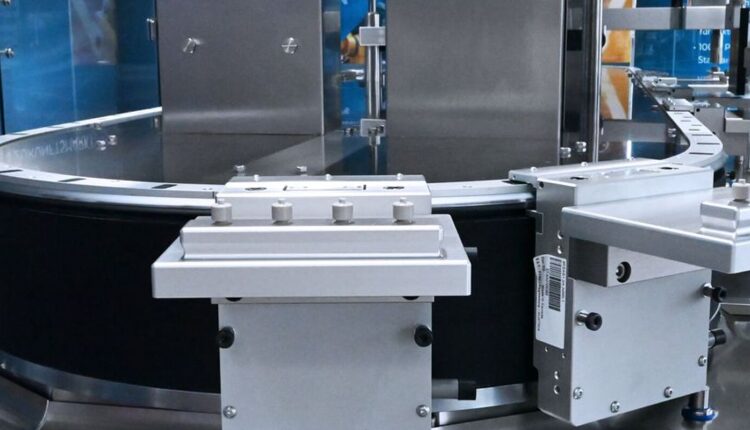B&R Automation: Flexible Is The New Standard
With its new ProMoCurve assembly line for medical consumables, Strama-MPS demonstrates that standardization and flexibility are not mutually exclusive. The SuperTrak linear transport system from B&R drastically reduced the development time for product-specific assembly lines. For Strama-MPS customers, this means stable costs and more predictable delivery times.
“Medical consumables – like inhalers, insulin pens, lancing devices and laboratory disposables – are produced in large quantities and their design rarely changes. As a result, the lines that assemble these items run around the clock. Typically, when a variant or new product is needed, rather than modifying existing lines, new ones are built,” explains Andreas Höcherl, Head of Innovation & Strategic Projects MedTech at Strama-MPS.
When it comes to the production of medical consumables, quantity and quality are equally important. Each step in the process must be completed in seconds and be absolutely reliable. In almost every case, this means building a highly specialized solution.
“The assembly process needs to be tailored to the exact product being made, and that makes it very difficult to standardize anything,” adds Höcherl. “With B&R’s SuperTrak transport system, however, we’ve managed to achieve a whole new level of standardization while still being able to respond flexibly to our customers’ requirements.”
Andreas Höcherl, Head of Innovation & Strategic Projects MedTech
“With B&R’s SuperTrak transport system, we’ve managed to achieve a whole new level of standardization while still being able to respond flexibly to our customers’ requirements.”
SuperTrak is a modular and flexible track system from B&R. It uses electromagnets to move shuttles safely, dynamically and precisely along the track. Unlike the rigid timing and spacing of conventional workpiece transport with indexing tables and belt transfer systems, each SuperTrak shuttle can be assigned its own unique movement profile via software. It is also easy to expand the system by adding more shuttles or track segments.
Less engineering, more reliability
Strama-MPS engineers have used SuperTrak to define machine modules that can be combined as needed without having to change the overall concept. Three standardized module types are currently available: one linear module and two corner modules. The housing, the central line shaft drive for the process stations and the stationary parts of the SuperTrak system (linear motors, guide rails, power supply, controller) are all predefined. The work area with the cams, the production area with the shuttles and the control cabinet are all mechanically separated from each other. The control software for SuperTrak runs on an Automation PC 910, a powerful industrial PC from B&R, which Strama-MPS uses for systems with up to three linear modules.
“The number of motor segments and the type of power supply modules to operate the shuttles can be reliably determined during planning using the simulation tool in B&R’s engineering software. The combination of standardization and simulation makes it possible to order many components earlier than before and with less coordination overhead. This makes us faster in building the modules and improves delivery reliability,” reports Höcherl. “With less of our time and energy going into engineering, we can focus instead on designing the process stations and assembly sequences.”

48+ stations per line
A linear module is just two meters long and 2.3 meters deep. The prototype that Strama-MPS uses to demonstrate the potential of its new system consists of one linear module and is equipped with six testing and assembly stations for the production of cannulas. The overall cycle time is 1.7 seconds. Each shuttle is equipped with a workpiece carrier that holds four cannulas. Since assembly steps are performed on each set of four simultaneously, the cycle time per cannula is actually only 0.4 seconds.
Process stations that take less than the cycle time can be made more efficient by taking advantage of SuperTrak’s free positioning capability. Instead of imaging and inspecting the cannulas in sets of four, the shuttle positions each cannula in front of the camera for its own close-up. This results in higher resolution images and improved fault detection. In the case of a slower process, the faster cycle time can be maintained by implementing multiple stations for that process and distributing the shuttles between them.
Despite the small footprint, each linear module offers space for up to 16 process stations. This makes it possible to construct lines with 48 stations or more. Strama-MPS engineers are able to achieve this high station density thanks to the compact SuperTrak design, which allows them to place stations both inside and outside the oval-shaped track. “SuperTrak is exactly what we needed to implement our concept,” adds Höcherl. “In the cleanrooms where our customers operate their lines, every square inch saved is especially valuable.”
But the modular line concept doesn’t stop there: Additional stations, such as infeeds and outfeeds, can easily be installed in the curved areas of the corner modules.
The total package
For Strama-MPS, SuperTrak’s compact design was a central argument in its favor. Other important factors included SuperTrak’s high payload, positioning precision and GMP-compliant design, together with the collaboration B&R offered. As Höcherl emphasizes: “We want to cooperate with our most important suppliers in a spirit of trust, support each other and advance technologically. Above all, it’s about the total package – and that’s what we found at B&R.”
This is of particular importance to Strama-MPS as the company aims to further expand its position in the medical technology market with its new assembly lines. Judging by the resonance the demo system has experienced at trade fairs such as Automatica, it seems they are definitely on the right track.
This content was originally published on the B&R Automation website.

